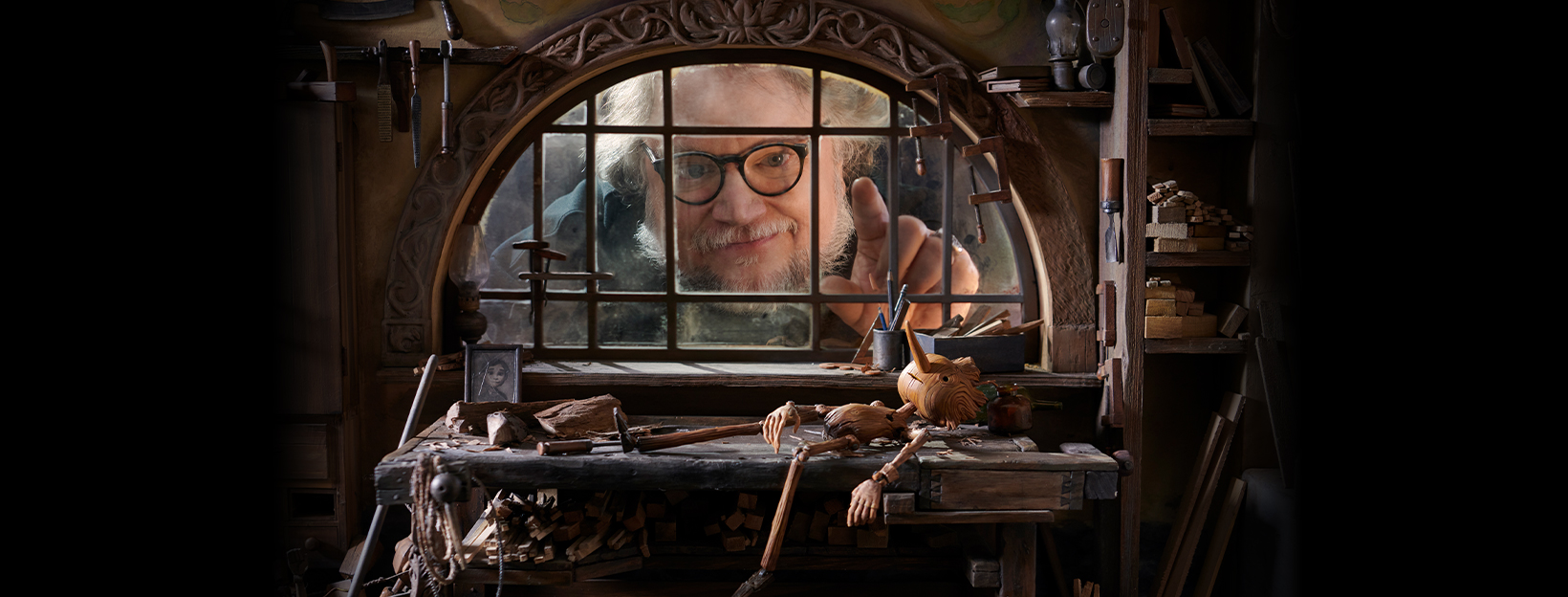
Film Editor Jess Parker reviews Guillermo del Toro’s Pinocchio: Handcarved Cinema, finding Netflix’s new mini-doc to provide an intriguing insight to del Toro’s stop motion adaptation
Released to Netflix on the 9th December 2022, Guillermo del Toro’s Pinocchio: Handcarved Cinema provides a brief, behind-the-scenes run through of the production process behind Guillermo del Toro’s Pinocchio (2022). This mini-documentary spans just less than 40 minutes, and covers many aspects of the creative process behind the Mexican filmmaker’s latest venture.
Guillermo del Toro’s Pinocchio: Handcarved Cinema documents and discusses the different creative and practical approaches used throughout the making of the source film. Guillermo del Toro’s Pinocchio is not a simple adaptation. Del Toro tells the classic tale through an anti-fascist lens, seeing Pinocchio (Gregory Mann) and Geppetto (David Bradley) navigate the tensions of their familial bond before the backdrop of Benito Mussolini’s Italy.
“This effectively differentiated Pinocchio from the characters around him, isolating him as something other through his individual stop motion style
One of the most interesting production details featured within the mini-documentary is the puppet design for Pinocchio. Although del Toro favoured mechanical puppets with silicone overlays for most of the characters, only hard plastic appeared to believably replicate solid wood. Therefore, a vast range of 3D printed faces used for replacement animation were produced, and exchanged throughout scenes to rapidly change the base puppet’s emotions. This effectively differentiated Pinocchio from the characters around him, isolating him as something other through his individual stop motion style.
Another impactful stylistic choice that is highlighted in Handcarved Cinema is the very purposeful use of distinctive colour signatures throughout Pinocchio to enhance the atmospheric nature of the film’s environments and characters. This is most notable in the Fascist camp, and in the underworld. When Pinocchio is recruited by Podestà (Ron Perlman) to join “The Elite Military Project for Special Patriotic Youth”, a fascist training camp for children, the scene is washed with burnt red and black hues. For the creatures and settings of the underworld, the screen is overrun with otherworldly blues and purples.
“There are rarely big dramatic build-ups to musical numbers, they simply flow throughout the dialogue naturally
Guillermo del Toro’s Pinocchio: Handcarved Cinema notes how the film’s musical numbers, composed predominantly by Alexandre Desplat, do not distract from the beauty and heart of the narrative, but seamlessly compliment it. There are rarely big dramatic build-ups to musical numbers, they simply flow throughout the dialogue naturally. Due to del Toro and Desplat’s interwoven use of song, Handcarved Cinema points to the fact that it is hard to categorise Pinocchio as a musical before all else; the film feels more comfortably situated as a fantasy tale that features musical numbers.
Del Toro often focusses on themes of family values and togetherness through his cinema, and Guillermo del Toro’s Pinocchio: Handcarved Cinema makes it clear that Pinocchio is certainly no exception. Familial burdens and expectations fuel Pinocchio’s rebellion against Geppetto’s rules, and catalyse the events that unfold. Del Toro notes that he often uses his own, personal experiences when dealing with familial themes, and that he does so when concerning Pinocchio and Geppetto’s relationship.

Guillermo del Toro’s Pinocchio: Handcarved Cinema does well to cover a broad range of topics through its 37 minute runtime, however, it does seem to rush through certain aspects of the production process that could be viewed in greater depth. Perhaps even extending the mini-documentary’s length by a mere 20 minutes would have allowed for Guillermo del Toro’s Pinocchio: Handcarved Cinema to feel like a more broadly thought through overview of the creation of Guillermo del Toro’s Pinocchio, rather than a whistle-stop tour of the film.
In addition to the mini-documentary’s unfortunately fast paced structure, Guillermo del Toro’s Pinocchio is fairly confusing when introducing new members of the production team to narrate different sections. Many of the talented team members are very hastily introduced, so for casual viewers of del Toro’s work, it is hard to keep track of what role each member had to play in Guillermo del Toro’s Pinocchio’s creation.
Verdict
Guillermo del Toro’s Pinocchio: Handcarved Cinema is a worthwhile addition to Guillermo del Toro’s Pinocchiofor anyone who enjoyed the source film, with the technical and creative insights that feature throughout the mini-documentary adding a new layer of enjoyment to Pinocchio’s story. Although Handcarved Cinema is captivating throughout, the rushed structure, unfortunately, leaves viewers wanting more details on the topics at hand. Handcarved Cinema’s short runtime is most-likely to blame for its hasty walk through the creation of Guillermo del Toro’s Pinocchio.
7/10
Guillermo del Toro’s Pinocchio: Handcarved Cinema is streaming now on Netflix
For more recent streaming releases, check out these articles from Redbrick Film:

Comments